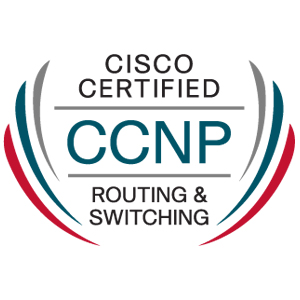
CCNP Routing Switching
Prerequisites
CCNA
Implementing Cisco IP Routing (ROUTE) 1.0
ROUTE
The ROUTE course will be made available at the end of February, 2010. Students may register for this class in advance through authorized Cisco Learning Partners.
Course Content
Implementing Cisco IP Routing (ROUTE) v1.0 is an instructor-led training course presented by Cisco training partners to their end customers. This five-day course and 7.5 hours of self-paced e-learning is designed to help students prepare for Cisco CCNP® certification. The ROUTE course is a component of the CCNP curriculum.
The ROUTE course is designed for network engineers with at least one year of professional work experience, who are ready to advance their skills and work independently on complex network solutions. Students will learn to plan, configure and verify the implementation of secure enterprise LAN and WAN routing solutions using a range of routing protocols. Course also covers configuration of solutions to support branch offices and mobile workers.
Course Objectives
Upon completing this course, the student will be able to meet these overall objectives:
- Plan and document the configuration and verification of routing protocols and their optimization in enterprise networks.
- Identify the technologies, components, and metrics of EIGRP used to implement and verify EIGRP routing in diverse, large-scale internetworks based on requirements.
- Identify, analyze, and match OSPF multiarea routing functions and benefits for routing efficiencies in network operations in order to implement and verify OSPF routing in a complex enterprise network.
- Implement and verify a redistribution solution in a multi-protocol network that uses Cisco IOS features to control path selection and provides a loop-free topology according to a given network design and requirements.
- Evaluate common network performance issues and identify the tools needed to provide Layer 3 path control that uses Cisco IOS features to control the path.
- Implement and verify a Layer 3 solution using BGP to connect an enterprise network to a service provider.
Course Outline
- Module 0: Course Overview
- Module 1: Planning Routing Services
- Module 2: Implementing an EIGRP based Solution
- Module 3: Implementing a Scalable Multiarea Network OSPF based Solution
- Module 4: Implement an IPv4 based redistribution solution
- Module 5: Implement Path Control
- Module 6: Connecting an Enterprise Network to ISP Networks
- E-Learning ROUTE-01 of 3: Implement Path Control
- E-Learning ROUTE-02 of 3: Implementing IPv6
- E-Learning ROUTE-03 of 3: Implementing Routing Facilities for Branch Offices and Mobile Workers
Implementing Cisco Switched Networks (SWITCH) 1.0
Course Content
Implementing Cisco IP Switched Networks (SWITCH) v1.0 is an instructor-led training course presented by Cisco training partners. This five-day course is designed to help students prepare for Cisco CCNP(R) certification. The SWITCH course is one of three components in the CCNP curriculum.
SWITCH is designed for network engineers with at least one year of professional work experience, who are ready to advance their skills and work independently on complex network solutions. Students will learn to plan, configure and verify the implementation of complex enterprise switching solutions using Cisco’s Campus Enterprise Architecture. The course also covers secure integration of VLANs, WLANs, voice and video traffic into campus networks.
Course Objectives
Upon completing this course, the student will be able to meet these overall objectives:
- Analyze campus network designs
- Implement VLANs in a network campus
- Implement spanning tree
- Implement inter-VLAN routing in a campus network
- Implement a highly available network
- Implement high-availability technologies and techniques using multilayer switches
- Implement security features in a switched network
- Integrate WLANs into a campus network
- Accommodate voice and video in campus networks
Course Outline
- Module 0: Course Overview
- Module 1: Analyzing Campus Network Designs
- Module 2: Implementing VLANs in Campus Networks
- Module 3: Implementing Spanning Tree
- Module 4: Implementing Inter-VLAN Routing
- Module 5: Implementing First Hop Redundancy in a Campus Environment
- Module 6: Implementing a Highly Available Network
- Module 7: Minimizing Service Loss and Data Theft in a Campus Network
- Module 8: Integrating Wireless LANs into a Campus Network
- Module 9: Accommodating Voice and Video in Campus Networks
Troubleshooting and Maintaining Cisco IP Networks (TSHOOT) 1.0
TSHOOT
The TSHOOT course will be made available at the end of February, 2010. Students may register for this class in advance through authorized Cisco Learning Partners.
Course Content
Troubleshooting and Maintaining Cisco IP Networks (TSHOOT) v1.0 is an instructor-led training course presented by Cisco training partners. This five-day course and 9.5 hours of self-paced e-learning is designed to help students prepare for Cisco CCNP(R) certification. The TSHOOT course is one of three components in the CCNP curriculum.
TSHOOT is designed for network engineers with at least one year of professional work experience, who are ready to advance their skills and work independently on complex network solutions. Students will learn to (1) plan and perform regular maintenance on complex enterprise routed and switched networks and (2) use technology-based practices and a systematic ITIL-compliant approach to perform network troubleshooting. Extensive labs provide for hands-on learning and reinforce troubleshooting skills..
Course Objectives
Upon completing this course, the student will be able to meet these overall objectives:
- Plan and document the most commonly performed maintenance functions in complex enterprise networks
- Develop a troubleshooting process to identify and resolve problems in complex enterprise networks
- Select tools that best support specific troubleshooting and maintenance processes in large, complex enterprise networks
- Practice maintenance procedures and fault resolution in switching-based environments
- Practice maintenance procedures and fault resolution in routing-based environments
- Practice maintenance procedures and fault resolution in a secure infrastructure
- Troubleshoot and maintain integrated, complex enterprise networks
Course Outline
- Module 0: Curriculum Overview
- Module 1: Planning Maintenance for Complex Networks
- Module 2: Selecting Maintenance and Troubleshooting Tools and Applications
- Module 3: Planning Troubleshooting Processes for Complex Enterprise Networks
- Module 4: Maintaining and Troubleshooting Campus Switching-Based Problems
- Module 5: Maintaining and Troubleshooting Routing Based Solutions
- Module 6: Maintaining and Troubleshooting Network Security Solutions
- Module 7: Maintaining and Troubleshooting Integrated, Complex Enterprise Networks
- E-Learning TSHOOT-01: Troubleshooting Performance Problems on Switches
- E-Learning TSHOOT-02: Troubleshooting Wireless Connectivity
- E-Learning TSHOOT-03: Troubleshooting Voice over IP
- E-Learning TSHOOT-04: Troubleshooting Video
- E-Learning TSHOOT-05: Troubleshooting Multicast
- E-Learning TSHOOT-06: Troubleshooting NAT and PAT
- E-Learning TSHOOT-07: Troubleshooting DHCP
- E-Learning TSHOOT-08: Troubleshooting IPv6, OSPFv3, and RIPng
